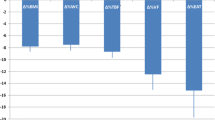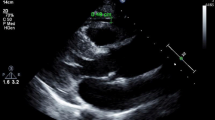Abstract
Introduction
Obesity is associated with decreased heart rate variability (HRV). Rosiglitazone, a PPARγ agonist, is generally associated with increases in body mass.
Purpose
To assess whether the gain in body mass and adiposity expected from rosiglitazone treatment has an influence on HRV in patients with type 2 diabetes and coronary artery disease.
Methods
One hundred and twenty-five patients with type 2 diabetes and coronary artery disease aged between 40 and 75 years were studied. Anthropometric measurements: (1) body mass index (BMI), (2) waist circumference (WC), (3) abdominal computed tomography (CT) scan, and HRV (using a 24 h Holter) were measured at baseline and after 12 months of treatment. Patients were randomized to rosiglitazone or placebo regimen.
Results
In the rosiglitazone vs. placebo group, there were significant increases in body mass [3.5 (2.6;4.4); mean (95 % CI) vs. 0.2 (−0.4;0.8)] kg), BMI [1.3 (1.0;1.6) vs. 0.1 (−0.1;0.3) kg/m2], WC [2.1 (0.9;3.3) vs. 0.4 (−0.4;1.2) cm, all p ≤ 0.001] and subcutaneous adipose tissue [253 (187;319) vs. 6 (−24;36) cm3, p ≤ 0.001] without statistically significant changes in visceral adipose tissue [−22 (−91;47) vs. 57 (43;71) cm3, p = 0.546], respectively. There was no change in HRV in either group after 12 months. There were no correlations between changes in HRV variables and fat distribution.
Conclusion
Our results suggest that changes in adiposity indices observed after 12 months of rosiglitazone therapy have no deleterious influence on HRV in patients with type 2 diabetes and coronary artery disease.

Similar content being viewed by others
Abbreviations
- HRV:
-
Heart rate variability
- PPARγ:
-
Peroxisome proliferator-activated receptor gamma
- BMI:
-
Body mass index
- WC:
-
Waist circumference
- CT:
-
Computed tomography
- CVD:
-
Cardiovascular disease
- VAT:
-
Visceral adipose tissue
- SAT:
-
Subcutaneous adipose tissue
- SNS:
-
Sympathetic nervous system
- PNS:
-
Parasympathetic nervous system
- T2D:
-
Type 2 diabetes
- TZD:
-
Sthiazolidinediones
- VICTORY:
-
VeIn Coronary aTherOsclerosis and Rosiglitazone after bypass surgerY
- CABG:
-
Coronary artery bypass graft surgery
- HbAlc :
-
Glycated hemoglobin
- NYHA:
-
New York Heart Association
- DEXA:
-
Dual-energy X-ray absorptiometry
- LDL-C:
-
Low-density lipoprotein cholesterol
- HDL-C:
-
High-density lipoprotein cholesterol
- CRP:
-
C-reactive protein
- FFA:
-
Free fatty acids
- TNF-α:
-
Tumor necrosis factor α
- Il-6:
-
Interleukine 6
- SDNN:
-
Standard deviation of all normal-to-normal (NN) interval
- SDANN:
-
Standard deviation of the averages of NN intervals in all 5 min segments of the entire recording
- rMSSD:
-
Square root of the mean of the squared differences between adjacent NN intervals
- NN50:
-
Number of pairs of adjacent NN intervals differing by more than 50 ms in the entire recording
- pNN50:
-
NN50 divided by the total number or all NN intervals
- VLF:
-
Very low frequencies
- LF:
-
Low frequencies
- HF:
-
High frequencies
- CI:
-
Confidence interval of 95 %
- TG:
-
Triglycerides
- HOMA-IR:
-
Homeostasis model assessment of insulin resistance
- ACE:
-
Angiotensin-converting enzyme
References
World-Health-Organization (2011) Global status report on noncommunicable diseases 2010
Despres JP, Lemieux I, Bergeron J et al (2008) Abdominal obesity and the metabolic syndrome: contribution to global cardiometabolic risk. Arterioscler Thromb Vasc Biol 28(6):1039–1049
Poirier P, Giles TD, Bray GA et al (2006) Obesity and cardiovascular disease: Pathophysiology, evaluation, and effect of weight loss. Arterioscler Thromb Vasc Biol 26(5):968–976
Wang Y, Rimm EB, Stampfer MJ et al (2005) Comparison of abdominal adiposity and overall obesity in predicting risk of type 2 diabetes among men. Am J Clin Nutr 81(3):555–563
Hillebrand S, Gast KB, de Mutsert R et al (2013) Heart rate variability and first cardiovascular event in populations without known cardiovascular disease: meta-analysis and dose-response meta-regression. Europace 15(5):742–749
Heart rate variability (1996) Standards of measurement, physiological interpretation and clinical use. Task force of the european society of cardiology and the north american society of pacing and electrophysiology. Circulation 93(5):1043–1065
Salamin G, Pelletier C, Poirier P et al (2013) Impact of visceral obesity on cardiac parasympathetic activity in type 2 diabetics after coronary artery bypass graft surgery. Obesity (Silver Spring) 21(8):1578–1585
Poliakova N, Despres JP, Bergeron J et al (2012) Influence of obesity indices, metabolic parameters and age on cardiac autonomic function in abdominally obese men. Metabolism 61(9):1270–1279
Saito I, Hitsumoto S, Maruyama K et al (2015) Heart rate variability, insulin resistance, and insulin sensitivity in japanese adults: the toon health study. J Epidemiol 25(9):583–591
Windham BG, Fumagalli S, Ble A et al (2012) The relationship between heart rate variability and adiposity differs for central and overall adiposity. J Obes 2012:149516
Shah P, Mudaliar S (2010) Pioglitazone: side effect and safety profile. Expert Opin Drug Saf 9(2):347–354
Vasudevan AR, Balasubramanyam A (2004) Thiazolidinediones: a review of their mechanisms of insulin sensitization, therapeutic potential, clinical efficacy, and tolerability. Diabetes Technol Ther 6(6):850–863
Bertrand OF, Poirier P, Rodes-Cabau J et al (2009) A multicentre, randomized, double-blind placebo-controlled trial evaluating rosiglitazone for the prevention of atherosclerosis progression after coronary artery bypass graft surgery in patients with type 2 diabetes. Design and rationale of the vein-coronary atherosclerosis and rosiglitazone after bypass surgery (victory) trial. Can J Cardiol 25(9):509–515
Canadian Diabetes Association Clinical Practice Guidelines Expert C, Goldenberg R, Punthakee Z (2013) Definition, classification and diagnosis of diabetes, prediabetes and metabolic syndrome. Can J Diabetes 37(Suppl 1):S8–S11
Pare A, Dumont M, Lemieux I et al (2001) Is the relationship between adipose tissue and waist girth altered by weight loss in obese men? Obes Res 9(9):526–534
Ferland M, Despres JP, Tremblay A et al (1989) Assessment of adipose tissue distribution by computed axial tomography in obese women: association with body density and anthropometric measurements. Br J Nutr 61(2):139–148
Mathieu P, Poirier P, Pibarot P et al (2009) Visceral obesity: the link among inflammation, hypertension, and cardiovascular disease. Hypertension 53(4):577–584
Neeland IJ, Ayers CR, Rohatgi AK et al (2013) Associations of visceral and abdominal subcutaneous adipose tissue with markers of cardiac and metabolic risk in obese adults. Obesity (Silver Spring) 21(9):E439–E447
Straznicky NE, Grima MT, Sari CI et al (2014) A randomized controlled trial of the effects of pioglitazone treatment on sympathetic nervous system activity and cardiovascular function in obese subjects with metabolic syndrome. J Clin Endocrinol Metab 99(9):E1701–E1707
Tchernof A, Despres JP (2013) Pathophysiology of human visceral obesity: an update. Physiol Rev 93(1):359–404
Lebovitz HE, Dole JF, Patwardhan R et al (2001) Rosiglitazone monotherapy is effective in patients with type 2 diabetes. J Clin Endocrinol Metab 86(1):280–288
Diamant M, Heine RJ (2003) Thiazolidinediones in type 2 diabetes mellitus: current clinical evidence. Drugs 63(13):1373–1405
Jensen MD (1997) Lipolysis: contribution from regional fat. Annu Rev Nutr 17:127–139
Kahn CR, Chen L, Cohen SE (2000) Unraveling the mechanism of action of thiazolidinediones. J Clin Invest 106(11):1305–1307
Raskin P, Rappaport EB, Cole ST et al (2000) Rosiglitazone short-term monotherapy lowers fasting and post-prandial glucose in patients with type ii diabetes. Diabetologia 43(3):278–284
Yamauchi T, Kamon J, Waki H et al (2001) The mechanisms by which both heterozygous peroxisome proliferator-activated receptor gamma (ppargamma) deficiency and ppargamma agonist improve insulin resistance. J Biol Chem 276(44):41245–41254
Goropashnaya AV, Herron J, Sexton M et al (2009) Relationships between plasma adiponectin and body fat distribution, insulin sensitivity, and plasma lipoproteins in alaskan yup’ik eskimos: the center for Alaska native health research study. Metabolism 58(1):22–29
Canale MP, Manca di Villahermosa S, Martino G et al (2013) Obesity-related metabolic syndrome: mechanisms of sympathetic overactivity. Int J Endocrinol 2013:865965
Saijo Y, Kiyota N, Kawasaki Y et al (2004) Relationship between c-reactive protein and visceral adipose tissue in healthy Japanese subjects. Diabetes Obes Metab 6(4):249–258
Tuininga YS, van Veldhuisen DJ, Brouwer J et al (1994) Heart rate variability in left ventricular dysfunction and heart failure: effects and implications of drug treatment. Br Heart J 72(6):509–513
Acknowledgments
VICTORY was designed and executed as an investigator-initiated trial and supported by an unrestricted grant from GlaxoSmithKline. This clinical study have been approved by the ethics committee of Institut universitaire de cardiologie et de pneumologie de Québec. The authors thank the staff and the patients from VICTORY trial for their important contribution. Dr. JP Després is the scientific director of the International Chair on Cardiometabolic Risk. Dr. P Poirier is a clinician-research scholar from the Fonds de la Recherche du Québec-Santé (FRQS). Dr. P Brassard is a Junior 1 research scholar from the FRQS.
Author information
Authors and Affiliations
Corresponding author
Ethics declarations
Conflict of interest
The authors have no relevant conflict of interests.
Rights and permissions
About this article
Cite this article
Grenier, A., Brassard, P., Bertrand, O.F. et al. Rosiglitazone influences adipose tissue distribution without deleterious impact on heart rate variability in coronary heart disease patients with type 2 diabetes. Clin Auton Res 26, 407–414 (2016). https://doi.org/10.1007/s10286-016-0373-7
Received:
Accepted:
Published:
Issue Date:
DOI: https://doi.org/10.1007/s10286-016-0373-7




